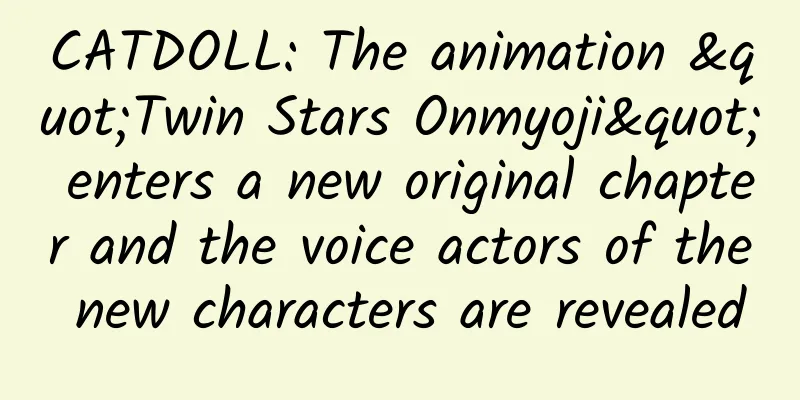CATDOLL: Where is the future of domestic animation?

|
As we all know, after the Japanese cartoon Totoro became popular all over the world, Disney and Marvel created a new generation of cartoon darlings - Baymax in "Super Hero 6". Both of them are chubby and cute in appearance, and their cute shapes are simply heartwarming. What's more worth mentioning is that "Super Hero 6" won the "Best Animated Feature Film" award at the 87th Academy Awards thanks to the cute Baymax, the technical effects of Hollywood blockbusters, and the heroic theme that the United States has always advocated. When talking about animation, most of us would first think of Japanese animation or American Disney, especially those born in the 1980s and 1990s who grew up watching "Doraemon", "Detective Conan", "Tom and Jerry", "Popeye" and other "imported products". There are very few Chinese animations in their memories, and the only ones that can leave an impression are "The Monkey King", "Black Cat Sheriff", "Big Head Son and Small Head Dad". We can't help but ask: China is the most populous country in the world, and it can be inferred that China also has more children than other countries. Why do our audiences and our children grow up watching foreign cartoons? Why can't China produce excellent cartoons? In recent years, Chinese animation has indeed made progress step by step with the support of the government and animation professionals. Cartoons such as "Pleasant Goat and Big Big Wolf" and "Boonie Bears" are also loved by children across the country. However, compared with Japanese and American animations, our animations are still a long way off, especially in the field of international communication. So, where is the road for Chinese animation? Some people have analyzed Japanese and American animations and believe that the excellence of Japanese animations lies in their thoughts and connotations. Even adults are willing to watch them, and people will gain different things from watching the same movie at different ages. American animations are better because they have the technical support of Hollywood, and the pictures are cool and dynamic. Some people have hastily concluded that if Chinese animations learn from Japanese thoughts and American technology, the problem will be solved. However, the development of Chinese animations is not so simple. Because we have indeed been practicing this idea for many years, but the results before us are not satisfactory. This is just like the historical reasons of some countries determine that they must take the capitalist road, while some countries are suitable for taking the socialist road. The same is true for Chinese animations. We cannot blindly copy other people's theories, but must find our own way. The first thing we need to change is our target audience. Everyone says that Chinese animation is childish, because it seems that its target audience has been defined as children since its birth, so we have only heard of "such and such children's" channels. It is true that children account for a large part of the target audience, but it has more potential audiences. For example, Japan is a country where everyone watches animation; Disney in the United States is both a paradise for children and a paradise for adults. In addition, to continue to make animation and do it well, we must take the path of industrialization. We must not be short-sighted and only care about immediate interests. Similar to Japanese animation, comics are first serialized in magazines, and then they are filmed if the feedback is good, and at the same time, the development of related industrial chains, such as cartoon dolls and stationery, is driven. In addition, China's 5,000-year cultural history has given it a wealth of creative themes, such as the previous "Monkey King" and "The Lotus Lantern", which have gained a good reputation. The United States has even used Chinese cultural resources to achieve success, such as "Mulan" and "Kung Fu Panda". Using local materials and traditional Chinese culture can not only attract audiences, but also educate children and spread Chinese culture to the world. In short, considering China's actual situation, repositioning, implementing industrialization, making good use of cultural resources, and taking a path of animation with Chinese characteristics is the right way. |
<<: CATDOLL: Domestic animation needs to keep pace with the times and innovate
>>: CATDOLL: Animator Wang Honghong is determined to make domestic animation better
Recommend
CATDOLL: "A Boring World Without Dirty Jokes" confirmed to be broadcast in July, voice actors announced
The previously leaked information was confirmed t...
CATDOLL: "A Certain Magical Index" and "Heavy Arms" cooperate
Official announcement: "A Certain Magical In...
CATDOLL: The new comic of "Kotoura-san" has been released online
The new work of the popular manga "Kotoura-s...
CATDOLL: Japanese netizens voted for the top yuri animations, and the cute girl kissing is the best
In Japanese anime, "yuri" is a very imp...
CATDOLL: The second season of "The Brave Adventure" will be aired. Nanpai Sanshu tells his thoughts in the video
The second season of the animation "Brave Ad...
CATDOLL: "Brave Adventure" will hold the second phase of the voice actor meeting and warm-up is in full swing
"Brave Adventure" will begin broadcasti...
CATDOLL: The final episode of "Girls' Number" previews Chitose regains the title of heroine
The preview images and text information of the fi...
CATDOLL: 10,000 people voted for the "most anticipated new show in October", and Lolita fans won
The October new animation feast is about to begin...
CATDOLL: Station B suddenly announced that the membership system is officially launched with an annual fee of 233 yuan
Bilibili (B Station), a domestic video website, h...
CATDOLL: Anime Starry Sky Evening News | "Hunter x Hunter" and "One Piece" comic previews "Macross Δ" announced to be adapted into a comic
Good evening, everyone. The manga information of ...
CATDOLL: "Death Note" live-action movie releases new PV, Light Yagami is still alive
Now that the release date of the live-action Deat...
CATDOLL: "Fox Spirit Matchmaker" cover competition ended successfully, super popular singing took the lead
The "Fox Spirit Matchmaker" cover compe...
CATDOLL: TV animation "Denpa Teacher" preview PV released
The TV animation "Denpa Teacher" which ...
CATDOLL: "One Piece" animation 766th episode advance picture is determined to take back Sanji
The 766th episode of One Piece animation will be ...
CATDOLL: 12 new characters appear in the animation "Danganronpa 3: The End of Hope's Peak Academy"
The TV animation "Danganronpa", adapted...









